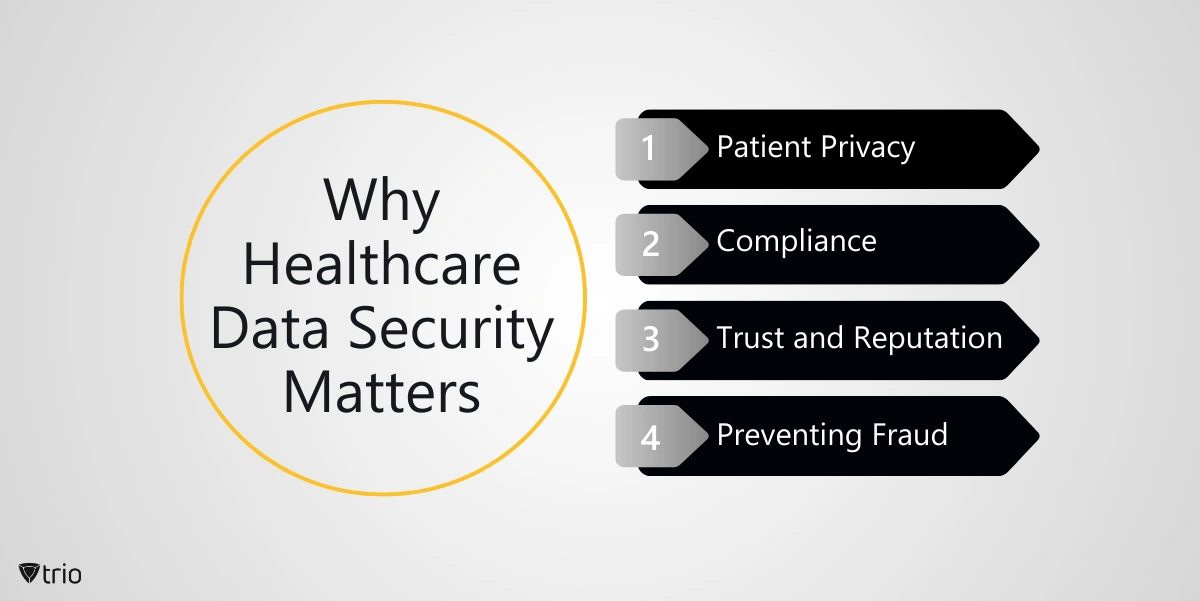In the digital era, healthcare organizations are increasingly dependent on electronic systems to manage patient information, enhance care delivery, and streamline operations. According to the Herjavec Group’s survey, approximately 70% of healthcare organizations experienced delays and longer hospital stays because of ransomware attacks. With the shift to digital records and the proliferation of health data, safeguarding this sensitive information has become extremely important. Read on to learn more about data privacy and security in healthcare and how to protect it.
What Is Data Security in Healthcare?
Healthcare data security refers to the measures and practices put in place to protect sensitive medical information from unauthorized access, disclosure, alteration, or destruction. Healthcare data encompasses a wide range of information related to an individual’s health, medical history, treatments, and interactions with healthcare providers. It includes both electronic and physical records. Here are some common types of healthcare data:
-
Patient Health Information (PHI)
This includes demographic information such as name, address, date of birth, and social security number, as well as medical information such as diagnoses, treatments, medications, and test results.
-
Electronic Health Records (EHR)
Digital records that contain comprehensive information about a patient’s medical history, including past illnesses, surgeries, allergies, medications, immunizations, and lab results. EHRs are used by healthcare providers to store and manage patient information.
-
Medical Imaging Data
This includes images such as X-rays, MRIs, CT scans, ultrasounds, and mammograms used for diagnosing and monitoring medical conditions.
-
Genetic Information
Data related to an individual’s genetic makeup, including DNA sequences, gene mutations, and family medical history. This information is increasingly used for personalized medicine and predicting disease risk.
-
Telehealth and Remote Monitoring Data
Information collected through telemedicine consultations, remote patient monitoring devices, wearable health trackers, and mobile health apps. This data can include vital signs, activity levels, medication adherence, and patient-reported symptoms.
-
Billing and Insurance Information
Data related to healthcare billing and payments, including insurance claims, billing codes, payment records, and financial transactions.
-
Research Data
Information collected as part of medical research studies, clinical trials, and epidemiological studies. This may include anonymized patient data, laboratory test results, and research findings.
-
Healthcare Provider Data
Information about healthcare professionals and organizations, including credentials, licensure, specialties, and affiliations.
-
Public Health Data
Data collected by public health agencies for monitoring and controlling the spread of diseases, tracking health trends, and conducting epidemiological research. This may include disease surveillance data, vaccination records, and population health metrics.
-
Healthcare Facility Operations Data
Information related to the administration and management of healthcare facilities, such as staffing schedules, facility maintenance records, and inventory management data.

What Is the Importance of Data Security in Healthcare?
Given the highly sensitive nature of healthcare data, ensuring its security and preventing data security issues in healthcare is crucial for several reasons:
-
Patient Privacy
Patients have a right to expect that their medical information will be kept confidential. Breaches of this privacy can lead to embarrassment, identity theft, or even discrimination.
-
Compliance
Healthcare organizations are subject to strict regulations regarding the protection of patient data, such as the Health Insurance Portability and Accountability Act (HIPAA) in the United States. Failure to comply with these regulations can result in hefty fines and legal consequences.
-
Trust and Reputation
Patients need to trust that their healthcare providers will safeguard their personal information. A breach can damage an organization’s reputation and erode patient trust.
-
Preventing Fraud
Healthcare data can be valuable to cybercriminals for various purposes, including insurance fraud. Secure systems help prevent unauthorized access and misuse of this data.

How to Ensure Healthcare Data Security Standards
Ensuring healthcare data security requires a comprehensive approach that addresses healthcare data security challenges. Here are some key steps to consider:
-
Risk Assessment
Conduct a thorough risk assessment to identify potential vulnerabilities and threats to healthcare data security. This includes assessing risks related to technology, personnel, processes, and external factors.
-
Implement Access Controls
Limit access to sensitive healthcare data to authorized personnel only using healthcare data security policies. Use strong authentication mechanisms such as passwords, biometrics, or two-factor authentication. Implement role-based access controls to ensure that users have access only to the information necessary for their job responsibilities.
-
Data Encryption
Encrypt healthcare data both in transit (while being transmitted between systems) and at rest (while stored on servers or devices). Use strong encryption algorithms to protect data from unauthorized access even if it is intercepted.
-
Regular Security Audits and Monitoring
Continuously monitor access logs, network traffic, and system activity for signs of unauthorized access or suspicious behavior. Conduct regular security audits and vulnerability assessments to identify and address security gaps proactively.
-
Employee Training and Awareness
Provide comprehensive training to healthcare staff on security best practices, including how to recognize and respond to security threats such as phishing emails, social engineering attacks, and malware. Promote a culture of security awareness throughout the organization.
-
Physical Security Measures
Implement physical security measures to protect devices and infrastructure that store or process healthcare data. This includes restricting access to data centers, server rooms, and other sensitive areas, as well as using security cameras, locks, and access control systems.
-
Data Backup and Disaster Recovery
Implement robust data backup and disaster recovery plans to ensure that healthcare data can be quickly restored in the event of data loss or system failure. Regularly test backup systems and procedures to verify their effectiveness.
-
Compliance with Regulations
Ensure compliance with relevant regulations and standards governing healthcare data security, such as the Health Insurance Portability and Accountability Act (HIPAA) in the United States. Stay informed about changes to regulations and update policies and procedures accordingly.
-
Vendor Risk Management
If third-party vendors or service providers are involved in handling healthcare data, conduct thorough due diligence to assess their security practices and ensure they comply with relevant regulations. Include security requirements in vendor contracts and agreements.
-
Incident Response Plan
Develop and maintain an incident response plan to guide the organization’s response to security incidents such as data breaches or cyberattacks. Clearly define roles and responsibilities, establish communication protocols, and conduct regular drills and exercises to test the effectiveness of the plan.
Conclusion
Ensuring healthcare data security is not just a regulatory obligation but a fundamental component of patient care and trust. By implementing comprehensive security measures—including risk assessments, access controls, encryption, regular audits, and robust incident response plans—healthcare organizations can protect sensitive data from breaches and unauthorized access. As the healthcare industry continues to evolve with technological advancements, maintaining vigilant and proactive security practices will be essential to safeguard patient information and uphold the integrity of the healthcare system.
Ensuring the security of your healthcare data is more critical than ever. Don’t leave your sensitive information vulnerable to breaches and unauthorized access. With Trio, our advanced Mobile Device Management (MDM) solution, you can safeguard your patient data with robust security features and compliance tools tailored for the healthcare industry. Check out Trio’s free demo today to safely automate much of the time-consuming processes regarding healthcare data security.








